

Biofield Evaluation of BaO & ZnS. 0WordPress0CiteULike0 New Barium oxide (BaO) and zinc sulfide (ZnS) are well known for their applications in electrical, optical and chemical industries.

The present study was aimed to evaluate the impact of biofield treatment on the structural and physical properties of BaO and ZnS powder. The study was carried out in two groups, one was set to control, and another group was subjected to Mr. Physical and Structural Characteristics of BaO & ZnS. BaO & ZnS- Effect of External Energy. Title: Influence of Biofield Treatment on Physical and Structural Characteristics of Barium Oxide and Zinc Sulfide Publication:
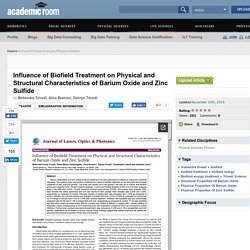
Human Energy Treatment. Description Barium oxide (BaO) and zinc sulfide (ZnS) are well known for their applications in electrical, optical and chemical industries.
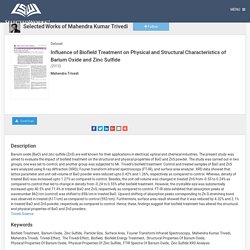
The present study was aimed to evaluate the impact of biofield treatment on the structural and physical properties of BaO and ZnS powder. The study was carried out in two groups, one was set to control, and another group was subjected to Mr. Trivedi’s biofield treatment. Control and treated samples of BaO and ZnS were analyzed using X-ray diffraction (XRD), Fourier transform infrared spectroscopy (FT-IR), and surface area analyzer. Citation Information. BaO & ZnS- Study of FT-IR Analysis. Barium oxide (BaO) and zinc sulfide (ZnS) are well known for their applications in electrical, optical and chemical industries.

The present study was aimed to evaluate the impact of biofield treatment on the structural and physical properties of BaO and ZnS powder. The study was carried out in two groups, one was set to control, and another group was subjected to Mr. Trivedi’s biofield treatment. Alteration of BaO & ZnS' Particle Size. Evaluation of BaO & ZnS- Biofield Impact. X-ray Diffraction Study of BaO & ZnS. Characteristics of Barium Oxide and Zinc Sulfide. Citation: Trivedi MK, Tallapragada RM, Branton A, Trivedi D, Latiyal O, et al. (2015) Inuence of Bioeld Treatment on Physical and Structural Characteristics of Barium Oxide and Zinc Sulde.

J Laser Opt Photonics 2: 122. doi:10.4172/jlop.1000122 Page 6 of 7 Volume 2 • Issue 2 • 1000122 J Laser Opt Photonics ISSN: JLOP, an open access journal. Barium Oxide & Zinc Sulfide. Mahendra Kumar Trivedi1, Rama Mohan Tallapragada1, Alice Branton1, Dahryn Trivedi1, Omprakash Latiyal2 and Snehasis Jana2* 1Trivedi Global Inc., 10624 S Eastern Avenue Suite A-969, Henderson, NV 89052, USA 2Trivedi Science Research Laboratory Pvt. Biofield Treatment’s impact on Salmonella Paratyphi. 0WordPress0CiteULike0 2 Enteric fever is a major global problem.
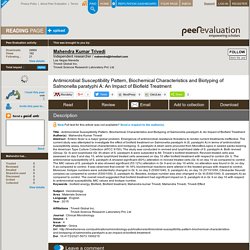
Emergence of antimicrobial resistance threatens to render current treatments ineffective. The current study was attempted to investigate the effect of biofield treatment on Salmonella paratyphi A (S. paratyphi A) in terms of antimicrobial susceptibility assay, biochemical characteristics and biotyping. S. paratyphi A strain were procured from MicroBioLogics in sealed packs bearing the American Type Culture Collection (ATCC 9150). The study was conducted in revived and lyophilized state of S. paratyphi A. Your session has expired but don’t worry, your message has been saved.Please log in and we’ll bring you back to this page. Your evaluation is of great value to our authors and readers. Salmonella paratyphi A: An Impact of Biofield Treatment.
Abstract Enteric fever is a major global problem.
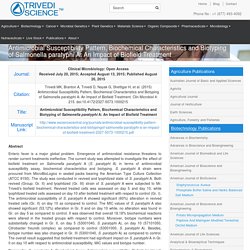
Emergence of antimicrobial resistance threatens to render current treatments ineffective. The current study was attempted to investigate the effect of biofield treatment on Salmonella paratyphi A (S. paratyphi A) in terms of antimicrobial susceptibility assay, biochemical characteristics and biotyping. S. paratyphi A strain were procured from MicroBioLogics in sealed packs bearing the American Type Culture Collection (ATCC 9150). Minimum Inhibitory Concentration. Impact of Biofield treatment on Salmonella Paratyphi. Responding into useful way that is called biofield energy and the process is known as biofield treatment.

Mr. Trivedi’s unique biofield treatment is also known as The Trivedi Effect®. Mr. Trivedi’s biofield treatment has been known to transform the. Energy Treatment Impact on the Characteristics of S. Paratyphi A. Description Enteric fever is a major global problem.

Emergence of antimicrobial resistance threatens to render current treatments ineffective. The current study was attempted to investigate the effect of biofield treatment on Salmonella paratyphi A (S. paratyphi A) in terms of antimicrobial susceptibility assay, biochemical characteristics and biotyping. S. paratyphi A strain were procured from MicroBioLogics in sealed packs bearing the American Type Culture Collection (ATCC 9150). The study was conducted in revived and lyophilized state of S. paratyphi A. Citation Information. S. paratyphi – Alternative Strategy for Enteric Fever. Enteric fever is a major global problem.
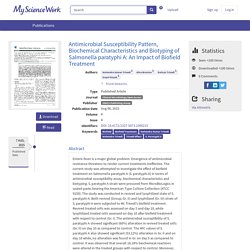
Emergence of antimicrobial resistance threatens to render current treatments ineffective. The current study was attempted to investigate the effect of biofield treatment on Salmonella paratyphi A (S. paratyphi A) in terms of antimicrobial susceptibility assay, biochemical characteristics and biotyping. S. paratyphi A strain were procured from MicroBioLogics in sealed packs bearing the American Type Culture Collection (ATCC 9150). The study was conducted in revived and lyophilized state of S. paratyphi A. Both revived (Group; Gr. Salmonella Paratyphi. Biochemical Characteristics of S. Paratyphi A. Alteration in Antimicrobial Susceptibility Pattern of S. Paratyphi. Enteric Fever and Salmonella paratyphi A. Mahendra Kumar Trivedi1, Alice Branton1, Dahryn Trivedi1, Gopal Nayak1, Harish Shettigar1, Sambhu Charan Mondal2 and Snehasis Jana2* 1Trivedi Global Inc., 10624 S Eastern Avenue Suite A-969, Henderson, NV 89052, USA 2Trivedi Science Research Laboratory Pvt.
Ltd., Hall-A, Chinar Mega Mall, Chinar Fortune City, Hoshangabad Rd., Bhopal-462026, Madhya Pradesh, India *Corresponding Author: Snehasis Jana Trivedi Science Research Laboratory Pvt. Received date: July 20, 2015 Accepted date: August 13, 2015 Published date: August 20, 2015. Increase in Crystallite Size: 2-Methylimidazole. Physical and Structural Characterization of Biofield Treated Imidazole Derivatives. Title: Physical and Structural Characterization of Biofield Treated Imidazole Derivatives Publication: Natural Products Chemistry & Research Select license: Assessment of Imidazole Properties. Description Imidazole derivatives have attracted significant interests in recent time for their usefulness in synthetic heterocyclic chemistry, analytical chemistry and pharmacology.
Aim of present study was to evaluate the impact of biofield treatment on two imidazole derivatives (i.e., imidazole and 2-methylimidazole) by various analytical methods. The biofield treatment was done by Mr. Trivedi on both the compounds and both control and treated samples of imidazole and 2-methylimidazole were characterized with respect to physical, and structural properties using X-ray diffraction (XRD), differential scanning calorimetry (DSC), thermogravimetric analysis (TGA), Fourier transform infrared (FTIR), ultraviolet-visible (UV-Vis) spectroscopy, and Gas chromatography-Mass spectrometry (GC-MS). X-ray diffraction study revealed that crystallite size varied in a different way for imidazole and 2-methylimidazole due to the presence of methyl group in 2-c position although their core was same.
Trivedi Effect. Imidazole derivatives have attracted significant interests in recent time for their usefulness in synthetic heterocyclic chemistry, analytical chemistry and pharmacology. Aim of present study was to evaluate the impact of biofield treatment on two imidazole derivatives (i.e., imidazole and 2-methylimidazole) by various analytical methods. The biofield treatment was done by Mr. Isotopic Abundance Ratio Analysis of Imidazole. Imidazole: FT-IR Spectroscopic Characterization. XRD Analysis of Imidazole. Characterization of Imidazole- Energy Impact. Volume 3 • Issue 5 • 1000187 Nat Prod Chem Res ISSN: 2329-6836 NPCR, an open access journal. Effect of Biofield Treatment on Imidazole. Visit for more related articles at Natural Products Chemistry & Research Abstract Imidazole derivatives have attracted significant interests in recent time for their usefulness in synthetic heterocyclic chemistry, analytical chemistry and pharmacology.
Evaluation of p-Dichlorobenzene Characteristics. 0WordPress0CiteULike0 New. TGA Analysis of p-Dichlorobenzene. Abstract Para-dichlorobenzene (p-DCB) is widely used as a chemical intermediate in manufacturing of dyes, pharmaceuticals, polymers and other organic synthesis. Impact of Human Energy Treatment on p-DCB. P-Dichlorobenzene: Alternative Strategy. Research Artilce Open Access Biochemistry & Analytical Biochemistry. Study of p-Dichlorobenzene- External Energy Treatment. P-DCB - A Chemical Intermediate in Manufacturing of Dyes. Para-dichlorobenzene (p-DCB) is widely used as a chemical intermediate in manufacturing of dyes, pharmaceuticals, polymers and other organic synthesis.
Alteration in p-DCB Characteristics. P-DCB' XRD Study- Biofield Impact. P-DCB: Physical, Thermal and Spectroscopic Properties. The Trivedi Effect. Mahendra Kumar Trivedi1, Alice Branton1, Dahryn Trivedi1, Gopal Nayak1, Ragini Singh2 and Snehasis Jana2* 1Trivedi Global Inc., 10624 S Eastern Avenue Suite A-969, Henderson, NV 89052, USA 2Trivedi Science Research Laboratory Pvt. Ltd., Hall-A, Chinar Mega Mall, Chinar Fortune City, Hoshangabad Rd., Bhopal- 462026, Madhya Pradesh, India *Corresponding Author: Snehasis Jana Trivedi Science Research Laboratory Pvt. Received Date: July 16, 2015; Accepted Date: August 21, 2015; Published Date: August 24, 2015.